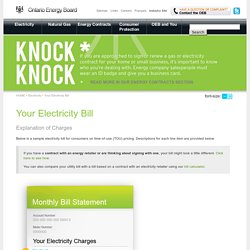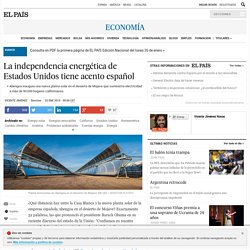

SaveONenergy. Professional Home Energy Audits. Your Electricity Bill. Explanation of Charges Below is a sample electricity bill for consumers on time-of-use (TOU) pricing.

Descriptions for each line item are provided below. If you have a contract with an energy retailer or are thinking about signing with one, your bill might look a little different. Click here to see how. You can also compare your utility bill with a bill based on a contract with an electricity retailer using our bill calculator. Electricity This line of the bill shows the price you are paying for the electricity you used during the billing period. Your utility buys the electricity it supplies to you from the wholesale market. Delivery This line of the bill shows the cost of delivering electricity from generating stations across the Province to your home or business via the high voltage (transmission) and low voltage (distribution) electricity systems. All the charges on the Delivery line of the bill are approved by the OEB.
Regulatory Charges 1. Included within this charge: 2. Six Canadian companies shaping the future of clean energy. This trailer-size battery is part of a smart-grid project with Hydro One, Toronto Hydro and Ryerson University.

Electrovaya By Richard Blackwell To truly fulfill the promise of green energy, producers are going to have to find a cheap way to store all that power for times when the wind isn’t blowing or the sun isn’t shining. The global energy storage market is expected to be worth as much as $230 billion by 2020. So far, tiny Canadian battery firm Electrovaya expects to capture $15 million of that in 2014, but it has big plans. The company has already built batteries for laptops, cars and ferries, and it is now scaling them up into trailer-size units to store power for utilities. An electrochemist, Gupta and his partner, solid-state physicist Jim Jacobs (son of urban activist Jane Jacobs), set up their first plant in Toronto’s urban core in the late 1990s. Energy Watch: Canada's energy poaching problem. ANALYSIS: Canada’s energy executives might want to try harder to keep their hands off their competitors.

It could soon cost them the growth they so crave. Production from Canada’s various sources of oil and gas are anticipated to double by the end of the next decade. To get there, the Petroleum Human Resources Council estimates the industry will need to recruit at least 125,000 new workers (replacing workface attrition is included) to pull all those extra barrels out of the ground. The problem is many of the new hires aren’t all that new. Mercer’s latest global oil and gas talent outlook found Canadian companies hire new workers from their competitors far more than oil and gas companies do globally. The chart above (courtesy of Marsh & McLennan) shows an average of 46 percent of all oil & gas companies globally get their new hires from competitors, while substantially more, about 56 percent of Canadian energy firms regularly follow the practice.
CanSIA. La independencia energética de Estados Unidos tiene acento español. ¿Qué distancia hay entre la Casa Blanca y la nueva planta solar de la empresa española Abengoa en el desierto de Mojave?

Exactamente 52 palabras, las que pronunció el presidente Barack Obama en su reciente discurso del estado de la Unión: “Confiamos en nuestra capacidad de reducir nuestra dependencia del petróleo extranjero y proteger nuestro planeta. Estados Unidos es hoy el número uno en petróleo y gas. Somos el número uno en energía eólica. Cada tres semanas introducimos en las redes la misma cantidad de energía solar que en todo el año 2008”. Esa independencia energética de la que alardea la primera economía del planeta tiene muchos nombres y apellidos. Abengoa celebró el viernes la inauguración de Mojave Solar, la segunda mayor planta mundial de tecnología cilindro parabolica, con una inversión de 1.600 millones de dólares (1.430 millones de euros al cambio actual) y ocho años de trabajo. “Este es un nuevo paso para Abengoa, que lleva treinta años de éxito en este país. Clean Energy Canada is a solutions-focused initiative working to accelerate Canada’s transition to an energy-efficient, ecologically responsible, and prosperous low-carbon economy.
Renewable Energy & Battery Suppliers. Home Page.